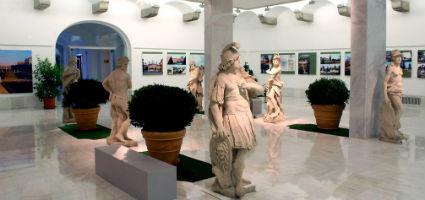2024. May 8. Wednesday
National Office of Cultural Heritage - Heritage Gallery - Budapest
 |
Address: 1014, Budapest Táncsics Mihály utca 1.
Phone number: (1) 225-4800
E-mail: koh@koh.hu
Opening hours: Mon-Sat 9-17
|
The exhibition has closed for visitors.
2009.06.04. - 2009.08.29.
The bridge connects. It creates a physical link between areas separated by water, a valley, road, railway or other obstacle. In a symbolic sense it is the path of the initiated from earth to heaven, from the physical world to the psychic world. Souls cross the river of the Underworld by it, yet it is also present in the sky, where the Milky Way symbolises the "bridge" spanning the darkness of the winter solstice.

The bridge is an ancient invention although it was not always an edifice. Once our ancestors merely used means offered by nature - fallen trees, rocks, branches and vines - to reach the far shore. Later beam and rope bridges emerged, and then in many cultures stone and fired bricks were used to build bridges. The era of iron and concrete began in the late 18th century, that of steel in the early 19th century and that of reinforced concrete at the end of the 19th century. Bridge building experts today are investigating the marriage of reinforced concrete and steel, and the use of plastics.
Bridge in Hungarian is híd, derived from the ancient Iranian Alan language dating from before the Magyars settled in the Carpathian Basin, which suggests that they brought bridge building technology here with them. It is no coincidence that híd is part of many place names such as Hidas, Hidasnémeti, Hídköz, Hídszeg and Sopronkőhida, implying the presence of a bridge there. Bridges of our past at times lead right up to the present and indeed beyond to the future. They deserve to be looked at more thoroughly so that we may learn more about them. This exhibition examines attractive, well-known and less well-known bridges that merit attention, shown from an unusual angle - thanks to photographer József Tóth's images bridging from soul to soul.

The bridge is an ancient invention although it was not always an edifice. Once our ancestors merely used means offered by nature - fallen trees, rocks, branches and vines - to reach the far shore. Later beam and rope bridges emerged, and then in many cultures stone and fired bricks were used to build bridges. The era of iron and concrete began in the late 18th century, that of steel in the early 19th century and that of reinforced concrete at the end of the 19th century. Bridge building experts today are investigating the marriage of reinforced concrete and steel, and the use of plastics.
Bridge in Hungarian is híd, derived from the ancient Iranian Alan language dating from before the Magyars settled in the Carpathian Basin, which suggests that they brought bridge building technology here with them. It is no coincidence that híd is part of many place names such as Hidas, Hidasnémeti, Hídköz, Hídszeg and Sopronkőhida, implying the presence of a bridge there. Bridges of our past at times lead right up to the present and indeed beyond to the future. They deserve to be looked at more thoroughly so that we may learn more about them. This exhibition examines attractive, well-known and less well-known bridges that merit attention, shown from an unusual angle - thanks to photographer József Tóth's images bridging from soul to soul.
